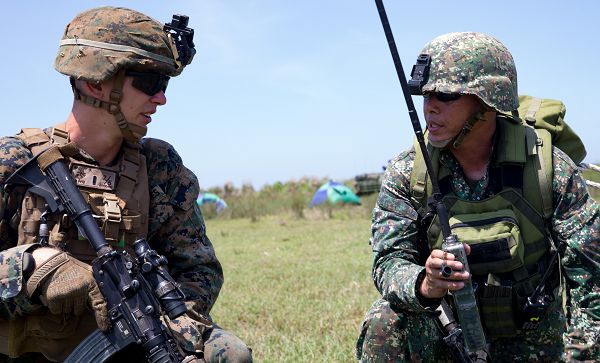
Naval Education Training Command, Philippines. (November 9, 2023): As tensions between the Philippines and China continue to rise, so too does the importance of the Marine Corps strategy of “Standing In” with our friends in the Indo-Pacific. In this photo by Lance Corporal Christine Phelps, Marine 1st Lieutenant Benjamin Radeff with Echo Company, 2nd Battalion, 5th Marines discusses the next objective with his counterpart, Philippine Marine 1st Lieutenant Barahama during exercise KAMANDAG 2, a bilateral event to maintain readiness.
KAMANDAG 2, or “Cooperation of the Warriors of the Sea”, is an exercise between the Republic of the Philippines and the United States that also includes recent participation from Japan. This Philippine-led exercise features military-to-military exchanges, live fire training, close air support, and a joint amphibious landing. The Marines trained alongside Philippine warfighters in jungle survival, urban environments, and combat life saving techniques.
These Marines may very well find themselves fighting side-by-side should war break out. Under a Mutual Defense Treaty signed in 1951, the United States is pledged to come to the aid of the Philippines if they are attacked and vice versa. This treaty was further strengthened in 2014 when the Philippines agreed to direct access to military facilities under a new Defense Cooperation Agreement. American officials have reassured the Philippines that “an armed attack on the Philippines armed forces, public vessels, or aircraft in the South China Sea would invoke US Mutual Defense commitments.”
As China has expanded its missile technology, U.S. war planners have focused on increasing the standoff range or the distance needed to keep American forces outside the kill zone.
As is typical for Marines, they have a more aggressive strategy.
While other forces pull back, the Marines have not only continued to operate in the shooting zone but have recently doubled down with its recently announced “Concept for Stand-In Forces.” Instead of keeping their distance, the Marines intend to create a few strike zones of their own and to maintain a “bellybutton to bellybutton” contact with the enemy regardless of missile range.
Exercises like KAMANDAG 2 not only increase readiness but also help the Marines develop lifelong friendships and connections with one of our longest allies and friends.


